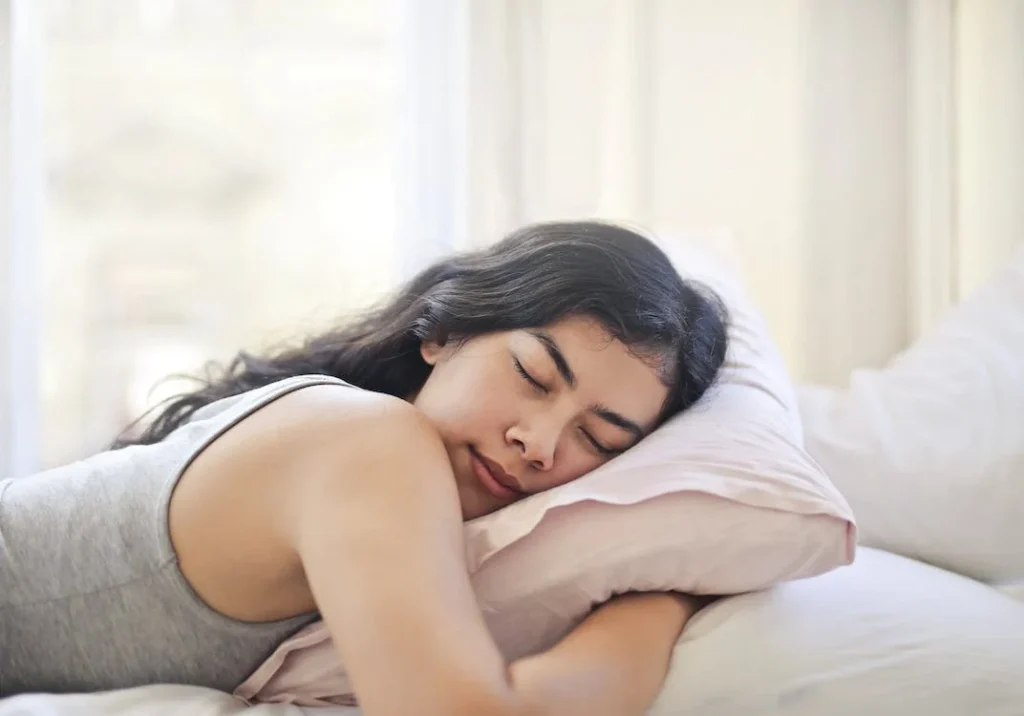Picture this – you finally crawl into bed after a long day, but try as you might, you just can’t seem to drift off to sleep. The reason could be none other than your mattress. People often buy a mattress without considering their sleeping position, and that leads to sleepless nights for many. People who snooze on their side might find a softer mattress more suitable, while someone who sleeps on their back might prefer a firmer one.
A suitable mattress provides proper support and comfort to the body, facilitating a healthy sleep posture and reducing the risk of body pain and discomfort.
Finding the perfect mattress is like finding your soulmate – it’s all about compatibility! The post aims to educate people about the different types of mattresses and how they can choose the right one based on their sleeping posture, so let’s get right into it.
Side Sleepers
Side sleeping is a popular position for adults, and for a good reason. It can improve breathing, reduce snoring, and even alleviate acid reflux. However, side sleeping impacts the mattress selection because this position can lead to pain in certain areas of the body, especially the shoulders, hips, and neck. The body has certain pressure points on hips and shoulders, which can lead to pain and discomfort.
A mattress that is too firm can create pressure points and cause discomfort, while a mattress that is too soft can cause the body to sink in too much, leading to improper spinal alignment. Therefore, choosing the right mattress is important for a goodnight’s sleep.
Evidence from Studies | The Need for a Softer Mattress
A study published in the Journal of Manipulative and Physiological Therapeutics found that a medium-firm mattress with a soft top layer reduced back pain and improved sleep quality in people with chronic low back pain, particularly for side sleepers. The study participants reported less pain and stiffness upon waking up, indicating that a softer mattress can help alleviate pain in the lower back, a common issue for side sleepers.
Best Mattresses for Side Sleepers
Listed below are two types of mattresses that are known to provide excellent support and comfort for individuals who sleep on their sides.
- Memory Foam Mattresses: These mattresses are constructed from a special viscoelastic foam that adapts to your body’s shape. They are popular because they contour to the sleeping person’s unique shape, leading to a comfortable sleep. This ability to conform to the body’s shape makes memory foam mattresses an excellent choice for side sleepers.
- Latex Mattresses: These mattresses, made from natural or synthetic rubber, are known for their support and ability to conform to your body’s shape. And, if that’s not enough, they’re also hypoallergenic and breathable, which means they’re perfect for allergy sufferers or anyone who tends to get a little too toasty in bed. Latex mattresses have become more popular as people are more inclined towards environmental sustainability.
Back sleepers
Back sleeping is a sleep position where an individual lies flat on their back with their arms by their side. This sleep position also has several unique characteristics that can impact mattress selection. Sleeping on your back means that your body weight is evenly distributed, which can help relieve pressure on your muscles and joints. But, it’s important to select a mattress that can provide the right support to keep your spine in alignment and prevent any pesky discomfort or back pain.
Mattress Selection Criteria
One of the critical considerations when selecting a mattress for back sleepers is the firmness level. A medium-firm mattress is often recommended for back sleepers as it can provide the necessary support to maintain proper spinal alignment.
A mattress that is too soft can cause the body to sink in, leading to misalignment of the spine, while a mattress that is too firm can cause discomfort and pain. A medium-firm mattress can distribute the weight of the body evenly and support the natural curvature of the spine, promoting a comfortable and restful sleep experience.
One study found that medium-firm mattresses were associated with better sleep quality, less back pain, and improved spinal alignment compared to soft or firm mattresses for back sleepers.
Best Mattress Choice for Back Sleepers
Below, we have listed a couple of mattress varieties that are particularly suitable for individuals who tend to sleep on their backs.
- Hybrid Mattresses: Hybrid mattresses are an excellent choice for back sleepers because they combine the best features of both foam and innerspring mattresses. For back sleepers who need just the right balance of support and pressure relief to keep their spines in perfect alignment, a hybrid mattress is the way to go. Some hybrid mattresses have zoning features, which provide targeted support to different areas of the body, such as the lower back, where back sleepers often experience discomfort.
- Innerspring Mattresses: These mattresses are a popular choice for back sleepers because they provide excellent support and allow for proper spinal alignment while sleeping. The coils in the mattress offer a firm surface that can contour to the body’s natural curves, providing a comfortable sleeping experience. Additionally, the airflow between the coils allows for good ventilation, which can keep back sleepers stay cool throughout the night.
Stomach Sleepers
Stomach sleeping is an uncommon sleeping position in which an individual sleeps on their stomach with their face turned to one side. One of the key characteristics of stomach sleeping is that it can help alleviate snoring and sleep apnea, as it helps keep the airways open and clear. This sleeping position is also useful towards treating pressure on your lower back and neck.
While sleeping on your stomach can be comfy, there are a few things to keep in mind. For example, it can put some strain on your neck and spine, which can lead to discomfort and pain. Not comfy! Plus, it can even cause wrinkles on your face from all that pillow-pressing action.
This brings us to the point – How to select the right mattress for stomach sleepers?
Mattress Selection Criteria
When it comes to mattress selection for stomach sleepers, it is important to consider the impact of this sleeping position on the body. Stomach sleeping puts more pressure on the neck, back, and hips, which can lead to discomfort and pain. As such, a firmer mattress is typically recommended for stomach sleepers as it prevents sinking and supports the body in a more neutral alignment.
A firm mattress helps to keep the spine in a straight and aligned position, preventing unnecessary pressure on the neck and back. Plus, it stops your hips from sinking too far into the mattress, which can make your spine feel all kinds of wonky. A supportive mattress that prevents sinking is particularly important for stomach sleepers, as they tend to apply more pressure to the mattress in this position.
Best Mattresses for Stomach Sleepers
Look for a mattress that can handle your pressure points and keep you comfy and supported all night long.
- Memory Foam Mattresses: These mattresses can be a good option for stomach sleepers because they conform to your body shape, providing pressure relief and support. Make sure it’s got a medium-firm feel. That way, you can ensure your body stays in a neutral position and doesn’t sink too far into the mattress. Your body will thank you for the extra support, and you’ll be snoozing like a baby in no time!
- Latex Mattresses: These mattresses are known for their firmness and responsiveness, which can help in keeping your body in proper alignment while sleeping on your stomach. They are also naturally hypoallergenic and resistant to dust mites, making them a good choice for those with allergies.
- Hybrid Mattresses: These mattresses combine the support of innerspring coils with the comfort of memory foam or latex. This combination allows stomach sleepers to sink in slightly while still being supported, which helps to prevent discomfort and stiffness in the neck and back. These mattresses often have a firmer feel, making them a good choice for stomach sleepers.
Combination sleeping
Combination sleepers typically move between different positions, such as sleeping on their stomach, back, or side, to find a comfortable sleeping position. According to sleep experts, combination sleeping is a common and healthy way to sleep, as it allows for better circulation and helps prevent joint pain and stiffness.
Mattress Selection Criteria
The characteristics of combination sleeping can have a significant impact on the selection of a suitable mattress. A mattress that is too soft or too firm may cause discomfort or pain when switching between different sleeping positions. A good mattress for combination sleepers should be able to adjust to your body’s unique shape and provide support to your pressure points, regardless of the sleep position you’re in.
It should also offer a balanced combination of firmness and softness to accommodate different sleeping positions. This means that the mattress should be soft enough to cushion your body when you sleep on your side, but also firm enough to support your back when you sleep on your stomach.
A mattress with good motion isolation is essential for combination sleepers who share their bed with a partner. Such a mattress will isolate motion and can help prevent disturbances from your partner’s movements, ensuring a good night’s sleep for both of you. Besides, no one wants to wake up on the wrong side of the bed.
Best Mattresses for Combination Sleepers
Below are several kinds of mattresses that may be suitable for individuals who tend to switch sleeping positions frequently.
- Memory Foam Mattress: These mattresses are a great option for combination sleepers because they contour to the body, providing personalized support and pressure relief, regardless of sleeping position. This means that whether a combination sleeper prefers sleeping on their back, stomach, or side, the memory foam mattress will adapt and support their body accordingly. Additionally, these mattresses have excellent motion isolation, which means that a partner’s movements won’t disturb the other person’s sleep.
- Latex Mattress: These mattresses are also a great option for combination sleepers, as they provide the ideal balance of support and comfort for those who switch positions frequently throughout the night. The unique structure of latex allows it to conform to the contours of the body while still providing enough bounce and firmness to keep the spine in proper alignment. This means that combination sleepers can enjoy a comfortable night’s sleep without waking up with aches and pains, regardless of which position they sleep in.
- Hybrid Mattress: The combination of innerspring coils and foam layers provides a balance of support and comfort that can accommodate various sleeping positions. The innerspring coils provide the necessary support for back and stomach sleeping, while the foam layers offer pressure relief for side sleeping. This combination helps to reduce motion transfer, allowing for a more restful night’s sleep.
- Adjustable Air Mattress: These types of mattresses can be customized to provide varying levels of firmness and support, making them ideal for accommodating the changing needs of combination sleepers. With the ability to adjust the firmness level of the mattress, combination sleepers can easily switch between back, side, and stomach sleeping positions without feeling any discomfort or pressure points.
The best mattress for all types of sleeping will depend on your personal preferences and body type. It’s important to test out different mattresses to see which one feels most comfortable and supportive.
Conclusion
Choosing the right mattress based on your sleep position is crucial for getting a good night’s sleep. With a plethora of mattresses on the market, selecting the right one can be daunting, but by taking into account your sleep position and preferences, you can narrow down your choices. A mattress should provide the right support and alignment to help prevent discomfort and pain. It is essential to keep in mind that each person’s sleeping position and preferences are different, so it is vital to find a mattress that works for you.
Additionally, enhancing your sleep quality can be achieved by practicing good sleep hygiene habits such as establishing a regular sleep routine, creating a relaxing sleeping environment, and refraining from consuming caffeine and alcohol.






